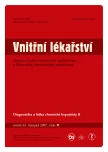Diagnostika a léčba chronické hepatitidy B
Doporučený postup České hepatologické společnosti České lékařské společnosti J. E. Purkyně a Společnosti infekčního lékařství České lékařské společnosti J.E. Purkyně
Authors:
P. Husa 1; S. Plíšek 2; J. Šperl 3
; P. Urbánek (koordinátoři) 4; J. Galský 5; P. Hůlek 6; P. Kümpel 7; V. Němeček 8
; M. Volfová (abecedně) 9
Authors‘ workplace:
Klinika infekčních chorob Lékařské fakulty MU a FN Brno, pracoviště Bohunice, přednosta prof. MUDr. Petr Husa, CSc.
1; Infekční klinika Lékařské fakulty UK a FN Hradec Králové, přednosta doc. MUDr. Václav Dostál
2; Klinika hepatogastroenterologie IKEM Praha, přednosta doc. MUDr. Julius Špičák, CSc.
3; Interní klinika 1. lékařské fakulty UK a ÚVN Praha, přednosta doc. MUDr. Miroslav Zavoral, Ph. D.
4; Infekční oddělení nemocnice Mělník, přednosta prim. MUDr. Jan Galský, Ph. D.
5; II. interní klinika Lékařské fakulty UK a FN Hradec Králové, přednosta prof. MUDr. Jaroslav Malý, CSc.
6; Infekční oddělení Slezské nemocnice Opava, přednosta prim. MUDr. Petr Kümpel
7; Národní referenční laboratoř pro virové hepatitidy Státního zdravotního ústavu v Praze, ředitel MUDr. Jaroslav Volf, Ph. D.
8; Hepato-Gastroenterologie HK s r. o., Hradec Králové
9
Published in:
Vnitř Lék 2007; 53(11): 1221-1230
Category:
Guidelines
Tento doporučený postup byl schválen výbory Česká hepatologické společnosti České lékařské společnosti J.E. Purkyně a Společnosti infekčního lékařství České lékařské společnosti J.E. Purkyně a byl současně zaslán k publikaci i v časopise Klinická mikrobiologie a infekční lékařství v září roku 2007.
Overview
Chronic hepatitis B is one of the world’s most common infectious diseases. In the Czech Republic it has a prevalence of 0.56%. Antiviral therapy for chronic hepatitis B demonstrably increases quality of life and where indication criteria are met and standard therapeutic procedures are followed, it is clearly cheaper than treatment for the complications of advanced cirrhosis of the liver or hepatocellular carcinoma. At the time of issuing of this recommendation, 4 medicines were classified for the treatment of chronic hepatitis B in the Czech Republic – pegylated interferon (IFN) α-2a, conventional IFN α, lamivudine (LAM) and adefovir dipivoxil (ADV). In a number of other developed states, entecavir (ETV) and telbivudine (LdT) have also been approved for treatment. The most effective treatment available at present is pegylated IFN α-2a, which should be the medication of first choice for initial treatment of hepatitis B, HBeAg positive and negative forms, provided that there are no contraindications for IFN α treatment. Conventional (standard, classical) IFN α can also be used, though clinical studies have shown it to be less effective than pegylated IFN α-2a. The main advantage of interferon compared to other commercially available medications is its relatively shorter and more clearly defined treatment period, the high probability of permanent suppression of virus replication and seroconversion of HBeAg/anti-HBe (in HBeAg positive forms of the illness) and the non-creation of mutant strains of HBV resistant to IFN in the course of treatment. If there are contraindications for IFN α (pegylated or conventional) or it is ineffective or poorly tolerated, ADV, ETV, LAM or LdT can be used. LAM and LdT treatments are often accompanied by the appearance of mutant strains of HBV, that are resistant to lamivudine or LdT and therefore they are not preferred.
Key words:
chronic hepatitis B – pegylated interferon (IFN) α-2a – interferon (IFN) α – lamivudine – adefovir dipivoxil – entecavir – telbivudine
Labels
Diabetology Endocrinology Internal medicineArticle was published in
Internal Medicine

2007 Issue 11
Most read in this issue
- Superior vena cava syndrome (definition, aetiology, physiology, symptoms, diagnosis and treatment)
- Rituximab (MabThera®) – a new biological medicine in rheumatoid arthritis therapy
- Diagnostic benefit of the use of implanted loop recorder (Reveal Plus) for patients with syncope with unclear aetiology
- Endoscopic diagnosis and treatment of biliary complications after laparoscopic cholecystectomy
